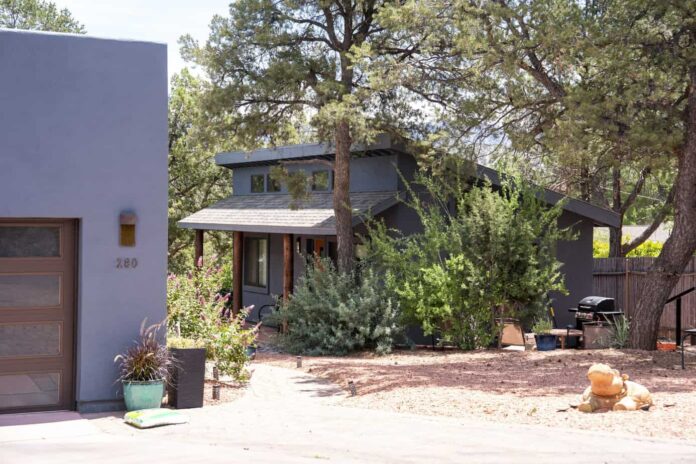During its July 16 meeting, the Cottonwood City Council passed two ordinances intended to encourage the construction of affordable housing by updating the city’s zoning ordinance to allow for the construction of more accessory dwelling units and to allow the city’s Community Development Department to offer incentives to developers to construct affordable housing.
Ordinance 747 replaced the definition of “guest house” in Cottonwood code with a new category: Accessory dwelling units, defined as dwelling units “subordinate to the principal dwelling” that may be either attached or detached to the main principal dwelling on a parcel, and removed “[A] guest house is kind of a flavor of accessory dwelling unit,” senior planner Gary Davis explained.
Davis said the updated language reflects the emphasis in the city’s new general plan on “flexibility in housing standards,” in part by deleting regulations “that didn’t seem to be needed.” Under the new rules, ADUs will be permitted by right on all lots where single-family homes are permitted.
An ADU cannot have a floor area greater than 75% of that of the main dwelling, with a cap of 1,200 square feet.
“We think this 1,200-square-foot cap keeps it consistent with the character of a residential neighborhood,” Davis said.
The update also eliminates the limitation of guest houses to certain residential zones and the requirement that they be occupied by members of the family occupying the main house. It deletes requirements for maximum lot coverage and minimum dwelling size, reduces front setbacks to 10 feet and side and rear setbacks to five feet and adjusts the allowable height for accessory buildings that encroach on side and rear setbacks from eight to 10 feet.
“It’s very hard to build a building that’s exactly eight feet or smaller,” Davis noted.
Resident Sharon King asked whether the new rules would permit an ADU to be taller than a single-family home if built above a garage.
“As long as it stays under the maximum allowable building height in that neighborhood,” Davis said. “Cities can’t require a maximum height that’s less than the regular building height … there isn’t a possibility to put a special lower building height on that.” The building height limitation on residential- zoned parcels in Cottonwood is 35 feet.
The new ADU ordinance brings Cottonwood’s zoning rules into compliance with state statute following the Arizona State Legislature’s passage of House Bill 2720 in May, which prohibited municipalities from imposing a number of restrictions on ADU construction, including zoning rules more restrictive than those applied to single-family homes or setting side or rear setbacks greater than five feet.
If municipalities do not adopt an ADU ordinance enacting the new rules by Jan. 1, 2025, ADUs will be allowed on all single-family-zoned parcels within those municipalities “without limits.” The second piece of legislation that the council passed, Ordinance 748, established a formal definition for the term “affordable housing” for the first time: “A residential development that is subject to a city-approved development agreement, with affordability controls under which, for a specified time, some or all of its dwellings must be offered at rent or sale prices that do not exceed a certain level in relation to the area median income.” The ordinance also added language to the city’s zoning ordinance to provide “for adjustments to development standards and to development fees to incentivize the development of housing that is affordable to households of low and moderate incomes.” “We don’t have the ability right now to offer incentives to reduce fees, increase building heights, reduce setbacks, things like that,” Davis explained. “This would specifically allow some further flexibility in the zoning ordinance for projects that do go that route and have the development agreement for true affordable housing.” Davis clarified that the incentives would apply to single homes and duplexes as well as larger projects. “I don’t see that there would be a limit on that if somebody really wanted to,” Davis said.
“I know a couple of builders that will build homes affordably, but they don’t have the capital or the means to do a 30- home subdivision,” Councilman Derek Palosaari said.
“Are you seeing appetite for this in the development community?” Mayor Tim Elinski asked.
“It’s hard to speculate on that, not having had this tool in place before,” Davis said.
Vice Mayor Debbie Wilden asked if a builder is already in the planning stages of a project, “can they come back and try to get some of these incentives?” “It would depend on the incentives they’re looking for,” Davis said. “We intended this to be pretty open-ended.” King wanted to know if the resulting development agreements would require approval by the Arizona Department of Housing as a “safeguard.” “I don’t believe there’s any requirement for any state involvement in a development agreement,” Davis said.
Council passed both ordinances unanimously in a total of 35 minutes.
House Bill 2720
Introduced by Representatives Carbone, Aguilar, Biasiucci, Cook, Grantham, Hendrix, Hernandez C, Livingston, Marshall, Ortiz, Peña, Quiñonez, Schwiebert, Smith, Willoughby, Wilmeth; & Senators Borrelli, Farnsworth, Fernandez, Gowan, Hernandez, Petersen, Rogers, Shamp
An Act
amending title 9, chapter 4, article 6, Arizona Revised Statutes, by adding section 9-461.18; relating to municipal planning.
Be it enacted by the Legislature of the State of Arizona:
Section 1. Title 9, chapter 4, article 6, Arizona Revised Statutes, is amended by adding section 9-461.18, to read:
9-461.18. Accessory dwelling units; regulation; definitions
A. A municipality with a population of more than seventy-five thousand persons shall adopt regulations that allow on any lot or parcel where a single-family dwelling is allowed all of the following:
1. At least one attached, detached or internal accessory dwelling unit as a permitted use.
2. A minimum of one additional accessory dwelling unit as a permitted use for each accessory dwelling unit on the lot or parcel that is a restricted-affordable dwelling unit.
3. An accessory dwelling unit that is seventy-five percent of the gross floor area of the single-family dwelling on the same lot or parcel or one thousand square feet, whichever is less.
B. A municipality may not do any of the following:
1. Prohibit the use or advertisement of either the single-family dwelling or any accessory dwelling unit located on the same lot or parcel as separately leased long-term rental housing.
2. Require a familial, marital, employment or other preexisting relationship between the owner or occupant of a single-family dwelling and the occupant of an accessory dwelling unit located on the same lot or parcel.
3. Prohibit or require kitchen facilities in an accessory dwelling unit.
4. Require that a lot or parcel have additional parking to accommodate an accessory dwelling unit or require payment of fees instead of additional parking.
5. Require that an accessory dwelling unit match the exterior design, roof pitch or finishing materials of the single-family dwelling that is located on the same lot as the accessory dwelling unit.
6. Set restrictions for accessory dwelling units that are more restrictive than those for single-family dwellings within the same zoning area with regard to height, setbacks, lot size or coverage or building frontage.
7. Set rear or side setbacks for accessory dwelling units that are more than five feet from the property line.
8. Require improvements to public streets as a condition of allowing an accessory dwelling unit, except as necessary to reconstruct or repair a public street that is disturbed as a result of the construction of the accessory dwelling unit.
9. Require a restrictive covenant concerning an accessory dwelling unit on a lot or parcel zoned for residential use by a single-family dwelling.
C. This section does not prohibit restrictive covenants concerning accessory dwelling units entered into between private parties. The municipality may not condition a permit, license or use of an accessory dwelling unit on adopting or implementing a restrictive covenant between private parties.
D. This section does not supersede applicable building codes, fire codes or public health and safety regulations, except that a municipality may not require an accessory dwelling unit to comply with a commercial building code or contain a fire sprinkler.
E. If a municipality fails to adopt development regulations as required by this section on or before January 1, 2025, accessory dwelling units shall be allowed on all lots or parcels zoned for residential use in the municipality without limits.
F. For the purposes of this section:
1. “Accessory dwelling unit” means a self-contained living unit that is on the same lot or parcel as a single-family dwelling of greater square footage than the accessory dwelling unit, that includes its own sleeping and sanitation facilities and that may include its own kitchen facilities.
2. “Gross floor area” means the interior habitable area of a single-family dwelling or an accessory dwelling unit.
3. “Long-term rental” means rental use in which the tenant holds a lease of ninety days or longer or on a month-by-month basis.
4. “Municipality” means a city or town that exercises zoning powers under this title.
5. “kitchen facilities” means a sink, refrigerator and a significant cooking appliance, including a range, stove, oven or microwave oven.
6. “Permitted use” means the ability for a development to be approved without requiring a public hearing, variance, conditional use permit, special permit or special exception, other than a discretionary zoning action to determination that a site plan conforms with applicable zoning regulations.
7. “Restricted-affordable dwelling unit” means a dwelling unit that, either through a deed restriction or a development agreement with the municipality, shall be rented or sold to households earning up to eighty percent of area median income.



